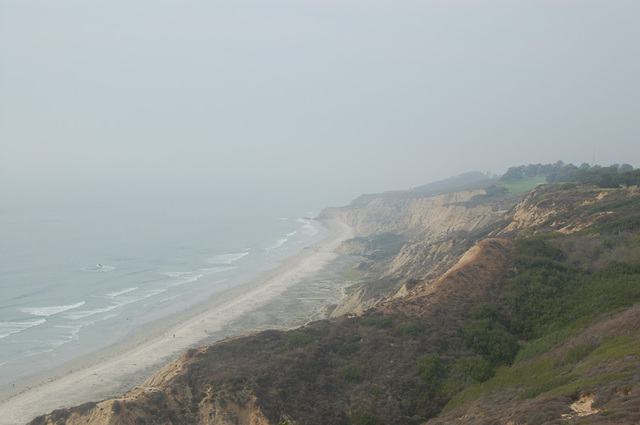Photography Bleg
I am only a novice photographer, but am trying to get better results than I used to with just a compact digital camera. I am using a Nikon D50, in this case with a 18-55 zoom lens and a UV filter. I am shooting at maximum res. and quality because I have a big memory card so what the heck.
This is the kind of shot that is frustrating the heck out of me. This was taken in the afternoon down the beach from the Torry Pines glider port. The problem is that the subject on this day looked gorgeous through the viewfinder, but the pictures are coming out looking much hazier than I remember it being. Is this a filter issue, a settings issue? Or is it just normal under certain light conditions? And is there anything in post-processing (e.g. photoshop) that I can do to get rid of some of the haziness? On the latter note, I played around with contrast and color saturation but couldn't get anything that looked natural. [click on thumbnail below to see larger version]
Update: I played around with this link in the comments, and got this, which is OK but I introduced some noise, but with some practice I got better.
After practicing, I tried it with my photos out the window of the London Eye and saw a great improvement, with before and after below:
Nothing substitutes, of course, for taking the right picture with the right initial settings at the right time of day, something I need a lot of practice on.
On the upside, I took some closeups of flowers that just looked gorgeous:





that is a great picture.
An UV filter might be what you need. Film and digital sensors pick up some near-UV light which adds haze to distant shots like that. They're pretty cheap, so give it a try.
You're in my backyard (I live in the foothills of San Diego County)!
Haze filters (in all cases, for the reasons cited by the preceding comment) and polarizing filters (especially if the haze is caused by water droplets) can help. Another "trick" for haze is to pick the right time of day, though if you're being a tourist that can be kinda hard.
Human perception is amazingly good at filtering out what it thinks is irrelevant (this is mostly in our brains, not our eyeballs). A good skill to develop as a photographer is the ability to observe those things that don't photograph well, but which you normally wouldn't notice. It just takes practice, and the digital cameras (with their instant playback) make this relatively easy. The situations that surprise me most often are haze, super-high contrast situations (mix of shade and full sun), and objects in the picture (like phone lines) that I just never noticed. Its definitely possible to train yourself to "see like the camera", and well worthwhile -- the payoff is consistently better photos...
Here's a link to Matt Hoy, a San Diego blogger. He blogged on this subject earlier today.
http://www.hoystory.com/?p=3747
Link won't work. Sorry
If you look at a histogram, this is a classic case of too little contrast. There are no very low, or very high values. Fortunately, that is usually easy to fix in post-processing software. You just expand out to cover the entire range (the opposite case, of too much contrast, is pretty much irreversible; it's why I like to use film in my large format camera, still, sometimes).
I emailed you a copy of the photo, run through "Automatic Contrast Enhancement", using PaintShop Pro 9. I used "Darker" and "Natural" settings. If you use PhotoShop, I imagine it has a similar mode. Anyway, it's not great in the sky, but it improves the foreground tremendously.
In Photoshop the Levels command is probably the best option. It will help, but it can't put back what isn't there. There is also the curves command. Some people swear by it, but Levels is *much* easier to use.
There really isn't much you can do about haze. Polarizers may help, but probably not enough for you to be happy with the results. Polarizars kill light. Haze is stuff (water droplets and pollution) between you and the subject. When it comes to shooting the sky a polarizar's effectiveness depends on your angle to the sun. The closer the sun is to 90 degrees from the direction of your lens, the better they work. If the sun is in frame or directly behind you, they don't work at all.
UV filters are more or less coated glass. You said you had one on your lens. You can see how much haze reduction they really accomplish...very little if any. UV filters are good at protecting the glass of your lens. It's better to replaced a scratched UV filter for $10 than replace a $10^x lens.
Really the only thing you can do is, like Tom said, learn to see like a camera does. Our eyes are much better at seeing than cameras. Digital is an improvement over film in the range of lights and darks it can see, but still isn't anywhere close to the human eye.
The lower the sun is in the sky, the happier you'll be with your photos and overcast days are your friend. Good photography is as much about being in the right place at the right time as it is knowing what to do when you are there. Sometimes the only choice you have is between a mediocre picture and no picture, unless you have the freedom to return when conditions are more favorable.
Just found this tutorial this morning:
http://www.covingtoninnovations.com/dslr/aerial/
I also like the shadow/highlight tool in Photoshop for some situations like this; it's a little like curves but easier to use in my opionion.
Try going to Image/Adjustments/Shadow-Highlight and playing around with different levels of highlight recovery (set shadows to zero).